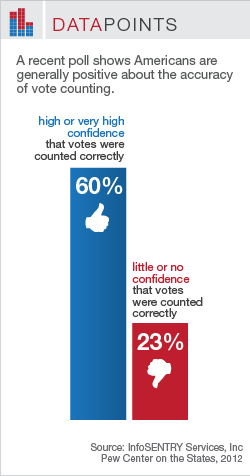Confidence in the Accuracy of Vote Counting
Return to Election Data Dispatches.
A majority of Americans are generally positive about the accuracy of vote counting in the U.S., according to the most recent edition of a survey that has been conducted annually since 2004 for InfoSENTRY, Inc. of Raleigh, NC, an information technology firm that provides consulting services to  state and local elections offices.
state and local elections offices.
The 2012 results show that 60 percent of adult respondents expressed either high or very high confidence that votes were counted accurately in their area, while 23 percent expressed either little or no confidence in election count accuracy.
However, the survey also shows a significant racial gap in confidence levels:
-
More than 60 percent of whites and Hispanics were confident that votes in their area were counted accurately, with just over 20 percent expressing little or no confidence.
-
By contrast, only 44 percent of African-American respondents expressed confidence and 33 percent expressed little or no confidence.






